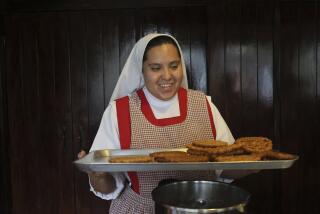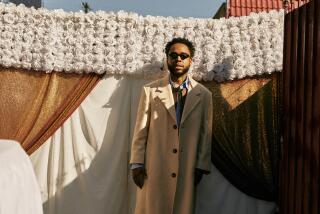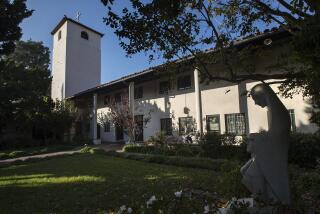Founder of Abbey Leaves a Legacy of Adventure and Faith
- Share via
The richness of Father Vincent Martin’s world can be seen in his 4-by-3-inch black leather address book.
Its robin’s-egg blue pages are neatly filled with the addresses of the famous: a countess, a cardinal, a glamorous Hollywood celebrity.
Other names are less known, but equally precious: simple monks who eschew earthly possessions, family in Brussels, colleagues in China, lifelong friends in Israel.
Martin, who died Tuesday at age 87, is best known for his founding of St. Andrew’s Abbey in Valyermo, which opens its doors once a year to the public to sell its famed ceramic images of saints and angels.
But among the monks at the abbey, nestled between the high desert and the San Gabriel Mountains near Littlerock, he is remembered as someone who knew wealth as well as poverty. He relished vigorous theological debate and plunged into foreign cultures.
His efforts to foster understanding between Jews and Christians also were notable. His work on many joint faith commissions and his books explored those relationships. On a more personal level, he was a frequent visitor to synagogues, donning Hebrew prayer shawl and yarmulke, reading from a Hebrew prayer book.
But it was Martin’s faith as a Benedictine monk that sustained him through a Japanese POW camp, the growing pains of starting a monastery in 1955 at a former Antelope Valley turkey ranch, and his barrier-breaking appointment as the first Catholic chaplain at Cedars-Sinai Medical Center in Los Angeles.
His monastic life began in 1928 when he joined the Benedictines at the Abbey of St. Andrew in Bruges, Belgium. Shortly after his ordination in July 1936, he and two monks eagerly left Belgium to open a monastery in China.
When war broke out, he became chaplain to the Chinese Christian soldiers who hunkered down with him as the Japanese attacked.
Later, after narrowly escaping execution in a Japanese POW camp, Martin staved off boredom by learning English and Russian from fellow prisoners.
Sister Karen Wilhelmy, a longtime friend, said the war left some imprints on Martin that surfaced periodically.
Once at a restaurant, she watched as he carefully carved “every last fiber” of meat off a bone. Her brother asked if he should order another meal for Martin, but she shrugged it off, and explained that he never wasted a morsel of food after his experience as a prisoner of war.
After the war, he attended Harvard and earned master’s and doctoral degrees in sociology.
But one of his most challenging assignments was in 1955, when the abbey in Belgium told him to set up a monastery in California and gave him $50,000 to do it.
The only affordable property was a 720-acre turkey ranch in a desolate high desert valley in the San Gabriel Mountains.
“If it wasn’t for Vincent, we wouldn’t have what we have,” recalled Brother Dominique Guillen. With its starkly beautiful isolation, the Valyermo monastery served as base camp for Martin’s travels to Israel and China, his teaching at UC Santa Barbara and his writings.
A longtime scholar of Israel, he had lived in Jerusalem for 10 years, studying at Hebrew University and at the Ecumenical Institute at Tantur, Israel.
Well versed in scholarly and cultural knowledge of Judaism, when Martin returned to the United States, he was selected as the first Catholic chaplain at Cedars-Sinai Medical Center. He also served on many Catholic-Jewish committees and commissions, recalled Rabbi Norman Pauker, who retired from the Mishkan Israel Congregation of North Hollywood.
But Rabbi Pauker’s fondest memory was their first meeting 28 years ago at a Catholic and Jewish gathering in Los Angeles. Rabbi Pauker sat alone at a table with kosher food. None of the other rabbis or priests sat with him. “Father Vincent came to join me,” he remembered Wednesday. “That was how our friendship began.”
Martin’s writings also explored the relationship between Christianity and Judaism, most notably in his 1995 book “A House Divided--the Parting of the Ways Between Synagogue and Church” and his 1998 booklet “Israelis and Palestinians at a Crossroads,” dedicated to actress Jane Wyatt.
However, it was probably Martin’s one-on-one encounters that forged his most powerful influence on Christian-Jewish relations.
On the first night of Hanukkah years ago at Cedars-Sinai, a patient wanted to light the first candle. Martin fetched a candle, brought it to the patient, and stayed with him during those special moments. “He told me about it in a nonchalant way the next day,” said Rabbi Levi Meier, a chaplain at the hospital.
Martin’s world extended far beyond the monastery. “I speak in English, think in French, move in Jewish circles and dream in Chinese,” he once said.
His survivors include a brother Pierre, of Belgium, and a niece, Marie Jeane Martin, of France.
Services are at 3 p.m. Sunday at St. Andrew’s Abbey in Valyermo.
More to Read
Sign up for Essential California
The most important California stories and recommendations in your inbox every morning.
You may occasionally receive promotional content from the Los Angeles Times.













